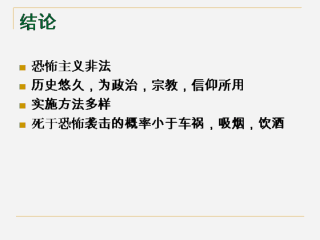| front |1 |2 |3 |4 |5 |6 |7 |8 |9 |10 |11 |12 |13 |14 |15 |16 |17 |18 |19 |20 |21 |22 |23 |24 |25 |26 |27 |28 | 29 |30 |31 |32 |33 |34 |35 |36 |37 |38 |39|40 |review |
 |
怎样帮助孩子理解恐怖主义:
•http://www.ed.gov/inits/september11/adults.html
•http://www.ed.gov/inits/september11/educators.html
•http://www.whitehouse.gov/news/releases/2001/09/letter2.html
•http://www.whitehouse.gov/news/releases/2001/09/letter1.html
•http://www.friendshipthrougheducation.org/
•http://www.ed.gov/PressReleases/09-2001/09192001c.html
Where you can find additional information and resources:
American Academy of Child and Adolescent Psychiatry
•American
Counseling Association
•American
Psychological Association Online: Help with Trauma
•Emergency
Services and Disaster Relief Branch, Center for Mental Health
•Helping
Children and Adolescents Cope with Violence and Disasters
•Helping
Children Cope with Disaster, National Parent Information Network
•High
Schools for Heroes
•National
Association of School Psychologists
•National
Center for Post-Traumatic Stress Disorder
•Post-Traumatic
Stress Disorder (PTSD), Trauma, Disasters, and Violence
•Talking
with Children When Disaster Strikes
•Ten
Tips to Help Your Kids Deal with Violence, Parenting Press
•Terrorism
and Children, Purdue University Extension
•University
of Oklahoma, Department of Pediatrics
•U.S.
Government Information and Resources in Response to September 11th
Events
|